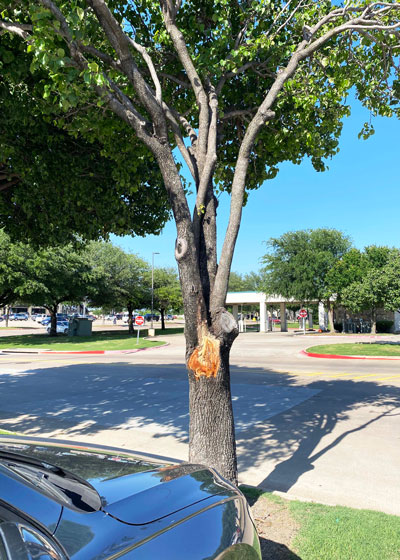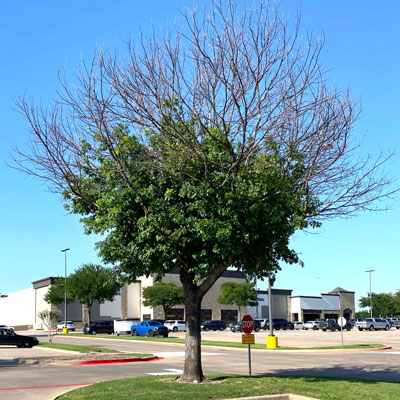Tree troubles
Lynn and I had had an especially long and hard day last Thursday. We ducked out for early dinner. As I got out of the car I told her I’d join her in just a moment. I saw two trees that I knew I’d want to discuss with you here.

Bradford pear…
These trees are absolutely beautiful in the spring when their branches are loaded with pristine white flowers. They’re lovely in the summer with their dark green leaves. Fall color is some of the best we see anywhere in Texas.
So, what’s not to like about Bradford pears? For one thing, their productive life expectancy in our landscapes is only 10 or 15 years. They form very narrow branch angles and the wood in those crotches becomes weak and very brittle. When a windstorm or ice storm rolls through the branches will break, often sending half of the tree crashing to the ground. That’s what has happened in this parking lot.
Faced with this, people often ask me how they can salvage the other half of the tree. Thinking of my photograph I ask them why they would want to do that? You would only perpetuate the inevitable. The other half will also split and the problem will continue until you have to have the tree cut down.
That’s when the second problem starts. Bradford pears send up root suckers from the rootstock, Callery pear. Those sprouts produce fruit that birds consume and subsequently “plant.” Callery pears have become invasive in much of the eastern United States – enough so that all of the ornamental pears have been banned in some areas.
All of this doesn’t even mention the pears’ susceptibility to fire blight and cotton root rot. But those, in the case of this tree in this parking lot, really aren’t important. What really matters is that this tree is a threat to anything parked near it.

Shumard red oak…
This tree, a Shumard red oak, is less than 100 feet from the Bradford pear. It was hurt in the cold of February 2021. I’ve been watching it for the past year. Unlike the Bradford pear, it normally would be one of our finest shade trees for Texas. However, it needs professional attention soon.
The top growth on this red oak has died back into the canopy because of the cold. Growing in the challenging environment of a parking lot adds stress to its health and vigor. That may have weakened it enough that the cold did its damage.
Now that the new growth for 2022 has leafed out, it’s apparent that this tree is going to rebound. A certified arborist, probably with a bucket truck, needs to prune out all of those dead branches before they become brittle, break and fall.
This tree can be saved and encouraged to regrow into a lovely specimen that will probably not even look worse for the wear within just a few years.
